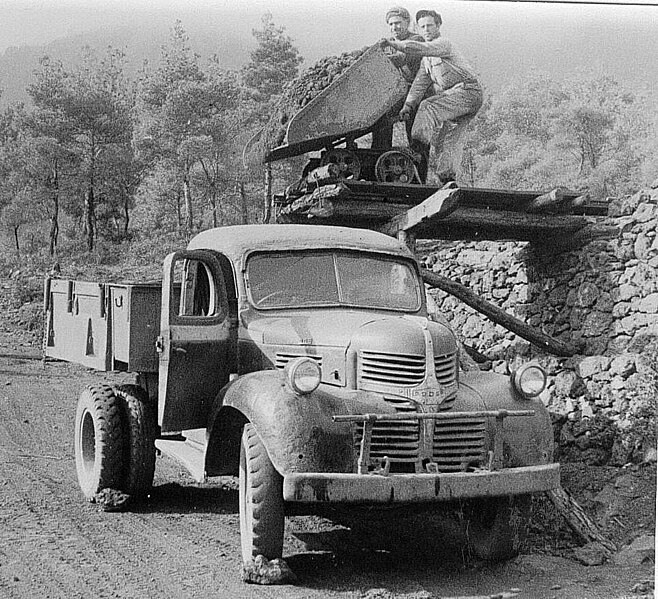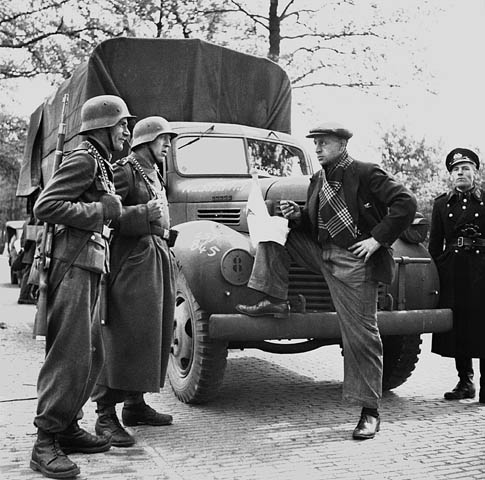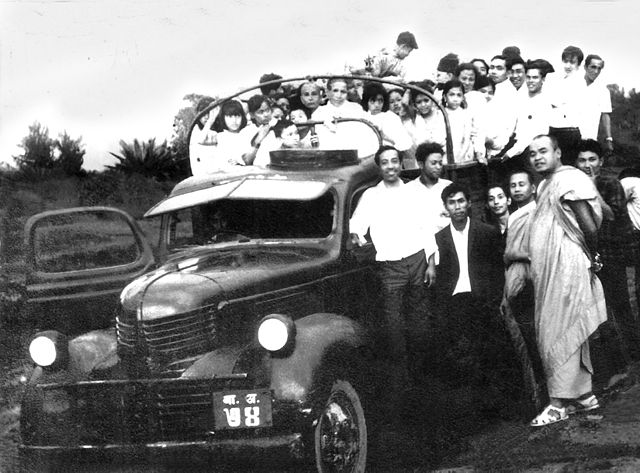Dodge WD-15
 USA (1941-47) c15,000 built.
USA (1941-47) c15,000 built.
Dodge's 1939 designations mess

The 1939 range at Dodge presented a brand new and completely redesigned line of truck with the T series from 1939, V series from 1940, and W series from 1941 (wartime) and up to 1947, as the "Dodge Job-Rated trucks". They all share the same cabin and bonnet, with a streamlined, Art Deco-style front sheetmetal and various configurations to offer customers a fitting model for any job and marketing this as buying new shoes.
The 1939 to 1947 Dodge truck range retrospectively became bewilderingly with a very large number of available variants identified by model codes through six different payload classes, many bodies and twenty different wheelbase lengths. To comound this, the bonnet could accomodate either variants of the straight six-cylinder Chrysler "Flathead" side-valve engines. By 1940 20 different truck frames were simultaneously produced and then 31 different chassis frames combined to 17 wheelbase lengths in 1947. Needless to say, from 1941, this array was diametrally opposed to the effort made by the US Government to impose standards trucks for amss production, both for the US army and allies under lend lease. The D-15 was just one of them, and perhaps one of the best known.
Historical significance
In World War II Dodge kept its peculiar styling from 1939 unchanged until 1947. Mass produced, they became popular postwar and were also produced by Fargo as the FH, FJ and FK-Series, by Plymouth as the PT-Series and by UK and Canada as the Dodge D15. In that case, they were manufactured at Kew in the United Kingdom and Windsor in Ontario respectively. From 1942 Dodge turned to mostly military production under the W-series.
Don Bunn, Dodge expert historian, had these Job-Rated trucks made as a milestone in the company's history, as the first mass-produced in the new Mound Road Warren truck plant, a properly gigantic facility as reported by the press as a symbol of US ingenuity for mass production. These Job-Rated trucks were also importznt as a base for the first light-duty military 4×4s mass produced as the WD series and the 1940 half-ton Dodge VC series. Postwar they derived into inconic models such as the Dodge Power Wagon. There was also a diesel-powered truck in this range. Due to their styme and predigree these trucks as prized by collectioners today and reputed very reliable.
The D-15 design

Mechanically however all these trucks were very similar: They had the same solid axles front and rear with leaf springs, same wheels and tires. But the style was new an unique. For its 1939 range, Dodge proposed a striking and modern design with updated drivetrains. It was all about streamlined styling, virtual requirement for anything designed at the time, and these new "Job-Rated" trucks adopted the "Streamline Moderne" Art Deco–based style, more aerodynamic with an elongated horizontal lines for the hood, and curving forms making it sleek and modern.
The Dodge D-15 had an all-steel cab featuring a long front-end design and barrel-shaped base, then sharp V-shaped grille. There were long and sleek crowned front and rear fenders. They were given embossed "speed lines" on their lower rears. There was a bew new and sloped two-piece windshield whuch could be opened for better airflow in summer. Headlamps were free-standing, mounted in bullet-shaped pods. From 1940, sealed-beam headlamps equipped with marker lights mounted on their housing started t be instroduced. The grille design was slightly changed in 1941.
As a Job-Rated truck, the D-15 had a stronger frame than previous Dodge designs. The steel used had a higher tensile strength. The frame-rails extended further forward past the engine. The large channel-type bumpers tied the rails together and reinforced the frame. Although the Dodge D-15 was part of 175 basic chassis models and seven engine variants, specific clutches, transmissions, axles, gear ratios, springs, tires and brakes, the payload was always the same, as the TD-15, VD-15 and WD-15 all were 3⁄4-ton rated. The D-15s had a 120 inches (305 cm) wheelbase, with the Express body pickup, 60.2 in (1.53 m) front track, 183.3 in (4.66 m), and a net weight of 3,200 lb (1,450 kg), 4,700 lb (2,130 kg) gross.
Its long bonnet housed a 217.8 cu in (3,569 cm3) engine rated for the T-114 Dodge 6-cyl. 4 liters 85 hp (63 kW) @ 3000 rpm capable of 170 lb/ft (230 N/m) @ 1200 rpm. It was coupled with a 3-speed manual gearbox, with High 1:1 / Low 3.3:1 hearing ratios. It could power the truck, loaded up to 1,500 lb (680 kg) at 62 mph (100 km/h) on 7.00" × 15" tires. For autonomy it had a lef-side 18 US gal (68 L) filled with 70 octane gasoline for a 162 mi (261 km) loaded. The D-15 was unarmed, apart the personal weapon of the truck driver, generally a Cold M1911.
Dodge D-15 specs. Express body pickup |
| Dimensions (L-w-h) | 183.3 x 74.1 x 75.8 in (4.66 x 3.05 x 1.83m) |
| Wheelbase | 120 in (1.88 m) |
| Gross weight | 4,700 lb (2,130 kg) |
| Payload | 3⁄4-ton or 1,500 lb (680 kg) |
| Crew | Driver, co-driver or 7 infantry |
| Propulsion | Dodge 217.8 cu in 85 hp (63 kW)/3000 rpm |
| Transmission | Three-speed manual |
| Top speed | 62 mph (100 km/h) |
| Max range | 18 US gal (68 L) tank, 162 mi (261 km) loaded |
The D-15 in service



These D-15 was a rear-drive only vehicle, with twin wheels axles made for supplies on road only, having limited off-road capabilities. Provided under lend-lease or builtin Canada it mostly saw action in north africa, brining in and out of the supply lines water, food, parts, ammunitions and reinforcements. The Canadian built Dodge D15 truck was widely used by the Canadian and British Army, especially in the N. Africa. Few D15's seem to have seen action in Western Europe.